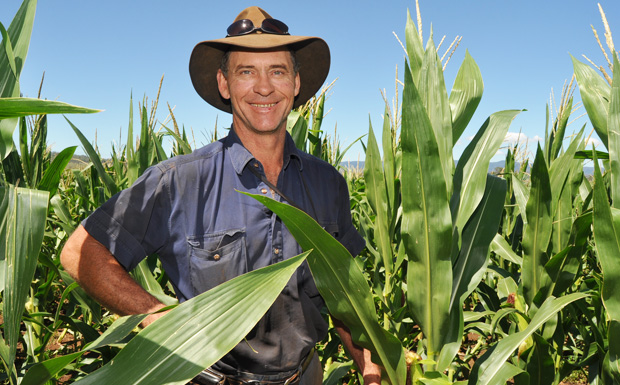
February 4, 2013
There’s no doubt that last weekend’s rain caused millions of dollars damage, and brought pain and grief to many Queenslanders … but even the darkest clouds can have a silver lining.
Many of the farmers around the South Burnett who’d been watching their corn and peanuts wilt in the paddocks, now have a smile on their face.
Alice Creek farmer Julian Cross received 280mm of rain over the Australia Day weekend.
Until then, his early planted corn had been “battling”. Now the crop has sparked up and Julian’s happy.
“It’s leaning in all sorts of directions, but it’s looking excellent. The rain came just in time. It rescued the corn from being cow feed,” Julian told southburnett.com.au today.
Julian’s also happy with how his peanuts are faring.
“The peanuts were flowering during the heatwave. This rain will rescue those flowers plus put down a new crop. The bushes are just exploding with new growth,” he said.
Julian’s now got his fingers crossed for a couple more showers before the peanut harvest, and he’s looking forward to better yields than last year.
Last year’s peanuts suffered because there was a dry spell followed by a cool, wet spell.
But this year, there’s also been hot weather, which the peanuts love.
Lionel Wieck, from the Peanut Company of Australia, is cautious about predicting a bumper crop (a lot can happen in 10 weeks) but he seems quietly confident.
While he didn’t want to downplay the damage that had been done to some individual properties in the region, overall there had been surprisingly little harm caused to peanut crops in the South Burnett by the Australia Day rain.
The exception was where there had been “running water”, ie where rainfall channelled into a gully or a creek rose.
PCA’s growers in other parts of Queensland also appear to have escaped the bullet.
Peanut crops at Tolga, in North Queensland, and around the Bundaberg area received about the same amount of rain as the South Burnett. The major Bundaberg floods also affected the north side of the river where few peanut growers are located.
Texas and Emerald peanut growers received about 100mm with no major damage reported.
About 550mm fell at Coulstoun Lakes, removing topsoil from areas that had been worked up to plant corn. However the paddocks which had already been planted with peanuts fared a lot better, Lionel said.
Most of the damage around the South Burnett occurred in non-peanut country, including around the Byee area where the water rose higher than the 2011 floods.
“At this stage, peanuts are being set up for a good potential but it depends on what happens,” Lionel said.
“They have had their big stress and now have had a big wake up call, which sets up a big potential, but we still need follow-up rain.”























